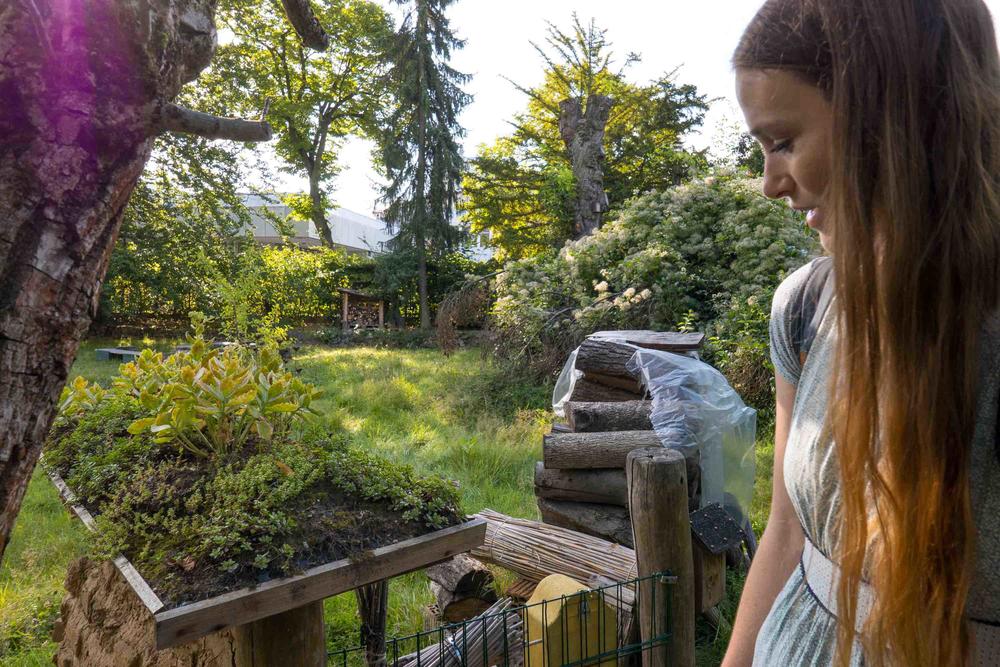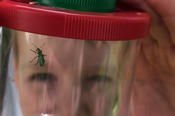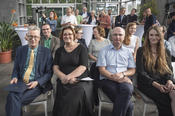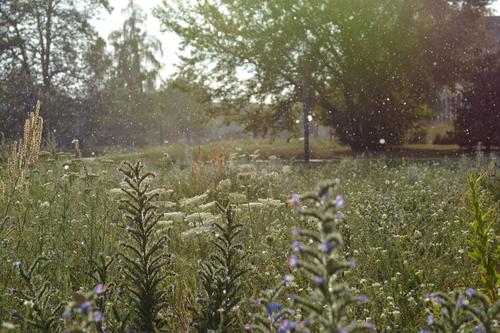Backyard Biodiversity
Rebecca Rongstock takes a look back at Freie Universität’s Year of Biodiversity
Feb 20, 2025
The “Blätterlaube” is a green oasis on campus where people connect with nature. It is home to a variety of measures to promote biodiversity, such as ponds, dead wood hedges, meadows containing rare plant species, birdhouses, and an insect hotel.
Image Credit: Marion Kuka
Freie Universität Berlin declared 2024 the Year of Biodiversity. Looking back, what conclusions can we draw? Rebecca Rongstock reflects on what worked well, what could be improved, and what the future holds for biodiversity at Freie Universität.
Rongstock is a trained biologist who works in the Unit for Sustainability and Energy Management at Freie Universität Berlin, where she is responsible for managing measures to promote biodiversity on campus. She also works in soil ecology at the Institute of Biology, where she is pursuing a doctorate on the impacts of global change and ecosystem restoration. In addition to her teaching responsibilities, she leads the “Blooming Campus” initiative as a volunteer.
Ms. Rongstock, what effect did the Year of Biodiversity have at Freie Universität?
Many divisions and people now work together more effectively when it comes to better protecting and promoting nature on campus. This is largely a result of the collaboration on the university’s Biodiversity Strategy and the numerous events that took place in 2024, for example, the science picnic in the Botanic Garden on the International Day of Biodiversity last May.
Volunteers, researchers, administrators, and the Executive Board are now pursuing shared goals and plans. A particularly positive result was our ability to motivate many students and employees to take part – for example, seventy people attended a think camp where we agreed upon a Biodiversity Strategy and guidelines for implementing it.
Additional concepts, for example, on dealing with invasive plant species, are currently in the pipeline. At the same time, we are busy implementing the approved measures. For example, the Facilities and Properties Service Unit has adapted its call for tenders regarding grounds maintenance. Contractors now have to adhere to certain practices in the name of promoting biodiversity, such as using specific machines, maintenance cycles, and techniques. This is because some machines that are commonly used in grounds maintenance are dangerous for meadow-dwelling insects and small vertebrates.
Biodiversity now also plays a larger role in teaching at Freie Universität. At the Institute of Biology, we are brainstorming ideas on how we can better integrate students into species monitoring activities on campus. This would help them gain experience in systematically collecting and evaluating data on different animal and plant species. The idea is that the students would also receive credit points for doing this. This local fieldwork approach is already being trialed in some modules. During the summer semester, one module was offered that focused primarily on nature on campus.
What were some of your favorite moments from the Year of Biodiversity?
A particular highlight for me was planting the “mini forest” last November with a group of dedicated volunteers. In total, we planted trees across an area of one hundred square meters. This mini forest acts as a natural air filter and helps to create a cooler microclimate. It also promotes the water retention capabilities of the soil, acts as a biodiversity hotspot, and serves as a place for learning about and interacting with nature.
I also found the students’ commitment in my “Campus Natur” seminar very inspiring. The same is true of my work with the children of university employees as part of the Feuerwanzen (Firebugs) program. In general, I am very proud that so many students, employees, and members of the university, both past and present, take part in our projects. The most important handyman right now used to work in the university canteen, and one of our regular contributors is a retired veterinarian who is over ninety years old.
Of course, it is especially satisfying when our work receives recognition off campus. For example, we won a gold award for our Blätterlaube community garden as part of the Germany-wide biodiversity campaign “Tausende Gärten – Tausende Arten” (One Thousand Gardens – One Thousand Species) and were awarded 3000 euros as part of the PSD ZukunftsPreis for the Blooming Campus initiative. These were some of the highlights of the past year. Our work also won the 2024 ISCN Excellence Award in the “Whole Systems Approach” category. The ISCN (International Sustainable Campus Network) is a global network aimed at promoting sustainability at universities.
Now the official Year of Biodiversity is over, what’s next?
For me and many other people, every year is a year of biodiversity. This means that many projects will continue. For example, the Multispecies Campus Living Lab is tasked with identifying species that are representative of the environmental needs of certain plants and animals that will then be actively encouraged on campus. The team, led by city ecologist Dr. Tanja Straka, is currently researching whether time spent in nature improves student well-being and is organizing an events day in summer featuring an art exhibition on the topic of biodiversity.
“There is so much to do!” Rebecca Rongstock combines research, teaching, and practical work.
Image Credit: Marion Kuka
We will be exchanging ideas and practices on monitoring ecology on campus with our partner universities in the Una Europa network at a workshop in February. We are also receiving more and more invitations from policymakers to take part in discussions on how to promote nature conservation activities in our cities. It is very interesting to see how the topic is beginning to resonate with local and state authorities.
What are the biggest obstacles or conflicts facing your work?
We lack time and knowledge. There is so much to do! Of course, it helps when projects are distributed among many people. However, this requires a solid base of specialist knowledge – or at least the ability to know how to inform yourself when it comes to sowing new plants or creating new habitats for insects.
Conflicts can arise in the space between public relations and nature conservation. We want to give everyone the opportunity to experience biodiversity for themselves, but nature also requires protected areas where it can develop undisturbed. This means finding good compromises.
Generally our measures have been met with surprisingly little resistance. Rather than receiving complaints about any “unkempt” meadows, we tend to get anxious phone calls from people who are concerned when they see that a meadow is being mowed. We then have to explain that is actually necessary to mow these meadows at least once or twice a year to promote biodiversity.
Even wildflower meadows need to be mowed once or twice a year to promote biodiversity.
Image Credit: Blühender Campus
When a breeding pair of kestrels occupied the elevator shaft of the Center for Continuing Education, the employees working there were even so kind as to tolerate a rather strong smell in the lobby of their building from time to time. We are working together with the Engineering and Utilities Division to offer the birds an alternative nesting location for the next breeding season.
What impact are the Berlin Senate’s budget cuts going to have on your plans?
At the moment no impact at all. Our activities are largely made possible by passionate volunteers. We have received a great deal of financial support from the Unit for Sustainability and Energy Management to date, and the new Biodiversity Strategy and the guidelines for implementing the strategy have created ideal conditions for our work. However, with better structures, improved quality, and more professionalism come additional costs. External funding programs can help with this to a certain extent. However, we need to get rid of the idea that biodiversity may be nice to have but is not something that is completely necessary. Or that measures to promote it should be free.
What are biodiversity enthusiasts up to in February?
Nature conservationists may be using this time of year to network, take part in discussions, or make plans for the year ahead. Scientists in the field are probably analyzing their field research data or writing up their results. And those who (also) advocate for biodiversity in their spare time are probably observing winter birds, studying local lichens, or following tracks in the snow. Of course, many of us are eagerly awaiting the first green shoots of spring.
Marion Kuka conducted the interview
The original German version of this article appeared in campus.leben, the online magazine published by Freie Universität Berlin.
Further Information
- Panel discussion on biodiversity on campus together with experts and representatives from partner universities in the Una Europa network: Thursday, February 20, 2025, from 6:30 p.m. in the Elisabeth Schiemann lecture hall, Königin-Luise-Straße 12–16, 14195 Berlin.
- The latest information on projects and events taking place at the Multispecies Campus Living Lab
- Workshop for students and university employees: “Tiere, Pflanzen, Menschen – gut zusammen leben auf dem Campus” (in German) – Please register
- More information on how to get involved with promoting biodiversity on campus








